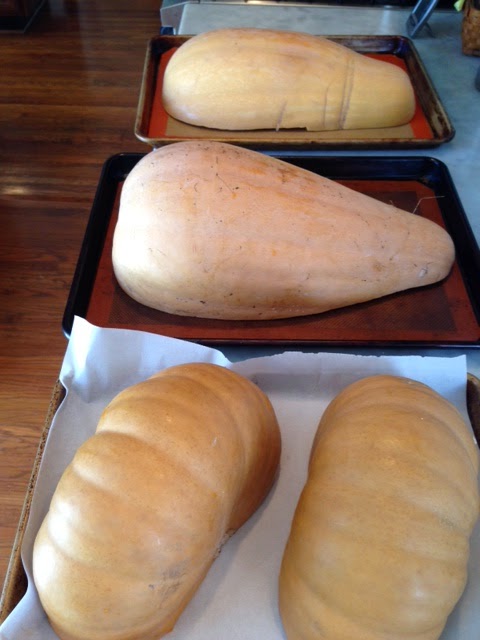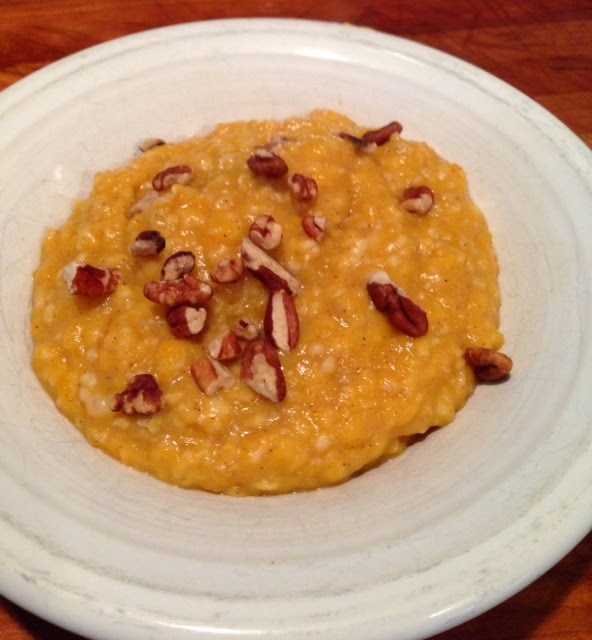One of my favorite garden goodies is pumpkin. Not the carving kind, but the sweet, delicious baking kind. Each year I browse the seed catalogs looking for new varieties of pumpkins to use in pies and other baked goods. Two of my favorites are Musquee de Provence and Long Island Cheese pumpkins.
Commercially canned pumpkin is nothing more that pureed pumpkin flesh. The homemade version is easy to make and preserve, and tastier. When selecting pumpkins, look for pumpkins labeled "pie" or "sweet". Seed catalogs will indicate pumpkin use and often suggest which varieties are best for baking.
Some recipes suggest preparing the flesh by boiling or steaming the pumpkin. I prefer roasting as it intensifies the flavor without adding additional moisture.
Once roasted and pureed, the pumpkin may need to be strained (some varieties have more moisture than others). Line a large strainer with cheesecloth or towel and allow to drain for an hour. Place drained puree in 2 cup containers (which is roughly equal to a 14 oz commercial can and the amount called for in most pie recipes) and place in the freezer. The USDA recommends pureed pumpkin be frozen, not canned.
 |
Right: Long Island Cheese pumpkin. Left: mysterious volunteer pumpkin.
Could be a cross as we didn't plant or compost this variety.
I'll roast to see if the flesh is suitable for baking. |
 |
| To prepare for roasting, cut in half and scrape out seeds. |
 |
| This large musquee de provence had to be cut into wedges to fit into the oven. |
 |
Place cleaned pumpkins cut side down on a rimmed baking sheet.
Roast at 375 degrees for about one hour.
Pumpkins are ready when flesh can be easily pierced with a paring knife.
The musquee de provence was roasted for 1 1/2 hours as the flesh is denser. |
 |
Roasted pumpkins. Use a tablespoon to scrape the flesh from the skin.
Unfortunately, the mystery pumpkin wasn't as tasty as
the other varieties, so I didn't include the flesh in the puree. |
 |
| Puree the flesh in a food processor. Process until smooth. |
 |
| Place puree in a lined colander and let drain for one hour. |
 |
| I usually give the puree a final squeeze just before placing into containers. |
 |
| Place puree in 2-cup containers and freeze. Use within one year. |
 |
What do I do with all that pumpkin?
I make pies, cookies and pumpkin casserole
(similar to sweet potato casserole). But one of my favorite dishes is pumpkin oatmeal.
It's delicious, comforting and I like that I sneak in a vegetable for breakfast! |
Pumpkin Oatmeal
This makes a generous amount of oatmeal. I like to make a batch early in the week and refrigerate leftovers. Then I heat a portion in the microwave for a quick, nourishing breakfast throughout the week.
2 cups fresh pumpkin puree or 1 (14-ounce) can pumpkin puree
2 cups water
2 cups milk
1/4 teaspoon kosher salt
3/4 teaspoon pumpkin pie spice
2 cups quick cooking oatmeal (not the instant kind)
Optional toppings: Honey, maple syrup, brown sugar, cream, raisins, pecans, roasted pumpkin seeds
In large saucepan over high heat, combine the pumpkin puree, water, milk, salt, and pumpkin pie spice. Bring to a boil. Add the oatmeal. Turn the heat down and cook according to your oatmeal instructions (about 5 minutes). Stir often. Serve with toppings. Refrigerate leftovers.




